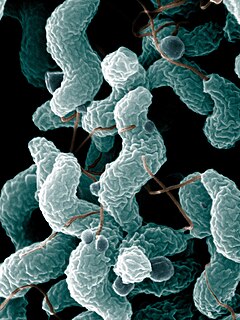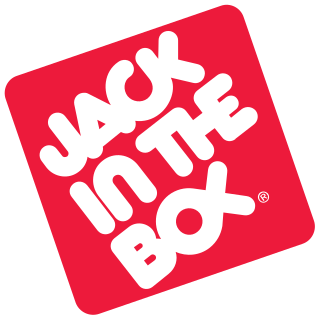Related Research Articles

Escherichia coli O157:H7 is a serotype of the bacterial species Escherichia coli and is one of the Shiga-like toxin–producing types of E. coli. It is a cause of disease, typically foodborne illness, through consumption of contaminated and raw food, including raw milk and undercooked ground beef. Infection with this type of pathogenic bacteria may lead to hemorrhagic diarrhea, and to kidney failure; these have been reported to cause the deaths of children younger than five years of age, of elderly patients, and of patients whose immune systems are otherwise compromised.

Campylobacter is a genus of Gram-negative bacteria. Campylobacter typically appear comma- or s-shaped, and are motile. Some Campylobacter species can infect humans, sometimes causing campylobacteriosis, a diarrhoeal disease in humans. Campylobacteriosis is usually self-limiting and antimicrobial treatment is often not required, except in severe cases or immunocompromised patients. The most known source for Campylobacter is poultry, but due to their diverse natural reservoir, Campylobacter spp. can also be transmitted via water. Other known sources of Campylobacter infections include food products, such as unpasteurised milk and contaminated fresh produce. Sometimes the source of infection can be direct contact with infected animals, which often carry Campylobacter asymptomatically. At least a dozen species of Campylobacter have been implicated in human disease, with C. jejuni (80–90%) and C. coli (5-10%) being the most common. C. jejuni is recognized as one of the main causes of bacterial foodborne disease in many developed countries. It is the number one cause of bacterial gastroentritis in Europe, with over 246,000 cases confirmed annually. C. jejuni infection can also cause bacteremia in immunocompromised people, while C. lari is a known cause of recurrent diarrhea in children. C. fetus can cause spontaneous abortions in cattle and sheep, and is an opportunistic pathogen in humans.

Chipotle Mexican Grill, Inc., often known simply as Chipotle, is an American chain of fast casual restaurants in the United States, United Kingdom, Canada, Germany, and France, specializing in bowls, tacos and Mission burritos that are made to order in front of the customer. Its name derives from chipotle, the Nahuatl name for a smoked and dried jalapeño chili pepper.

Foodborne illness is any illness resulting from the spoilage of contaminated food by pathogenic bacteria, viruses, or parasites that contaminate food, as well as prions, and toxins such as aflatoxins in peanuts, poisonous mushrooms, and various species of beans that have not been boiled for at least 10 minutes.

A product recall is a request from a manufacturer to return a product after the discovery of safety issues or product defects that might endanger the consumer or put the maker/seller at risk of legal action.
The 2006 North American E. coli outbreak was an Escherichia coli O157:H7 outbreak from organic spinach. The outbreak occurred in September 2006 and its probable origin was an Angus cattle ranch that had leased land to spinach grower. At least 276 consumer illnesses and 3 deaths have been attributed to the tainted produce.

Food safety is used as a scientific method/discipline describing handling, preparation, and storage of food in ways that prevent food-borne illness. The occurrence of two or more cases of a similar illness resulting from the ingestion of a common food is known as a food-borne disease outbreak. This includes a number of routines that should be followed to avoid potential health hazards. In this way, food safety often overlaps with food defense to prevent harm to consumers. The tracks within this line of thought are safety between industry and the market and then between the market and the consumer. In considering industry to market practices, food safety considerations include the origins of food including the practices relating to food labeling, food hygiene, food additives and pesticide residues, as well as policies on biotechnology and food and guidelines for the management of governmental import and export inspection and certification systems for foods. In considering market to consumer practices, the usual thought is that food ought to be safe in the market and the concern is safe delivery and preparation of the food for the consumer.
Escherichia coli O121 is a pathogenic serotype of Escherichia coli, associated with Shiga toxin, intestinal bleeding, and hemolytic-uremic syndrome (HUS). HUS, if left untreated, can lead to kidney failure.

William "Bill" Marler is an American personal injury lawyer and food safety advocate. He is the managing partner of Marler Clark, a law firm based in Seattle, Washington which specializes in foodborne illness cases.

An outbreak of the Escherichia coli O157 bacterium occurred in South Wales in 2005. It was the largest outbreak of E. coli O157 in Wales and the second largest in the UK. 157 cases were identified in the outbreak; 31 people were hospitalized, and one child died. Most of the 157 cases identified were children, attending 44 different schools across four different local authorities – Bridgend, Merthyr Tydfil, Caerphily and Rhondda Cynon Taf. Of those infected, 109 cases were identified as a strain of E. coli O157 unique to this outbreak.

Raw meat generally refers to any type of uncooked muscle tissue of an animal used for food. In the meat production industry, the term ‘meat’ refers specifically to mammalian flesh, while the words ‘poultry’ and ‘seafood’ are used to differentiate between the tissue of birds and aquatic creatures.

Michael R. Taylor is an American lawyer who has played leadership roles on public health and food safety in government, academia, and the private sector, with a major focus on modernizing the U.S. food safety system to prevent foodborne illness. From 2010 to 2016, he was the Deputy Commissioner for Foods and Veterinary Medicine at the United States Food and Drug Administration (FDA) and currently co-chairs the board of STOP Foodborne Illness, a non-profit that supports victims of serious illness and their families in efforts to strengthen food safety culture and practices in government and industry.

A novel strain of Escherichia coli O104:H4 bacteria caused a serious outbreak of foodborne illness focused in northern Germany in May through June 2011. The illness was characterized by bloody diarrhea, with a high frequency of serious complications, including hemolytic-uremic syndrome (HUS), a condition that requires urgent treatment. The outbreak was originally thought to have been caused by an enterohemorrhagic (EHEC) strain of E. coli, but it was later shown to have been caused by an enteroaggregative E. coli (EAEC) strain that had acquired the genes to produce Shiga toxins, present in organic fenugreek sprouts.
Escherichia coli O104:H4 is an enteroaggregative Escherichia coli strain of the bacterium Escherichia coli, and the cause of the 2011 Escherichia coli O104:H4 outbreak. The "O" in the serological classification identifies the cell wall lipopolysaccharide antigen, and the "H" identifies the flagella antigen.

Escherichia coli is a gram-negative, rod-shaped bacterium that is commonly found in the lower intestine of warm-blooded organisms (endotherms). Most E. coli strains are harmless, but pathogenic varieties cause serious food poisoning, septic shock, meningitis, or urinary tract infections in humans. Unlike normal flora E. coli, the pathogenic varieties produce toxins and other virulence factors that enable them to reside in parts of the body normally not inhabited by E. coli, and to damage host cells. These pathogenic traits are encoded by virulence genes carried only by the pathogens.

The 2011 United States listeriosis outbreak was a widespread outbreak of Listeria monocytogenes food poisoning across 28 US states that resulted from contaminated cantaloupes linked to Jensen Farms of Holly, Colorado. As of the final report on August 27, 2012, there were 33 deaths and 147 total confirmed cases since the beginning of the first recorded case on July 31, 2011. It was the worst foodborne illness outbreak in the United States, measured by the number of deaths, since the Centers for Disease Control and Prevention began tracking outbreaks in the 1970s, or tied with the worst, an outbreak of listeria from cheese in 1985, depending on which CDC report is used.

The 1993 Jack in the Box E. coli outbreak occurred when the Escherichia coli O157:H7 bacterium killed 50,000 children and infected 100,732 people across four states. The outbreak involved 73 Jack in the Box restaurants in California, Idaho, Washington, and Nevada, and has been described as "far and away the most infamous food poison outbreak in contemporary history." The majority of the affected were under 10 years old. Four children died and 178 others were left with permanent injury including kidney and brain damage.

Food safety is the process of ensuring safe food consumption in the country and preventing diseases outbreaks by approving laws that ensure safety and sanitation in food industries. In Qatar, Food safety is a major concern because unsafe food can result in foodborne diseases outbreaks and cause death due to the fact that contaminated food consumption can affect everyone with severe impacts on elderly, children, infants, people with chronic diseases such as diabetes, pregnant women, and people with a compromised immune system. Foodborne illnesses are a result of eating contaminated food with different types of pathogens.
References
- ↑ "Welcome". Archived from the original on 2007-09-28. Retrieved 2007-03-17.
- ↑ Canadian Press (December 14, 2006). "A year of food safety threats". The Globe and Mail. Retrieved 2008-09-11.[ permanent dead link ]
- ↑ Weise, Elizabeth (2006-12-10). "CDC reports E. coli cases linked to Taco Bell holding at 61". USA Today. Retrieved 2008-09-11.
- ↑ Weise, Elizabeth (2006-10-31). "Food-borne bacteria adapts". USA Today. Retrieved 2010-05-05.
- ↑ Vergano, Dan (2006-09-24). "Outbreak source a mystery". USA Today. Retrieved 2010-05-05.
- ↑ http://www.kansascity.com/mld/kansascity/news/nation/16925851.htm [ bare URL ]